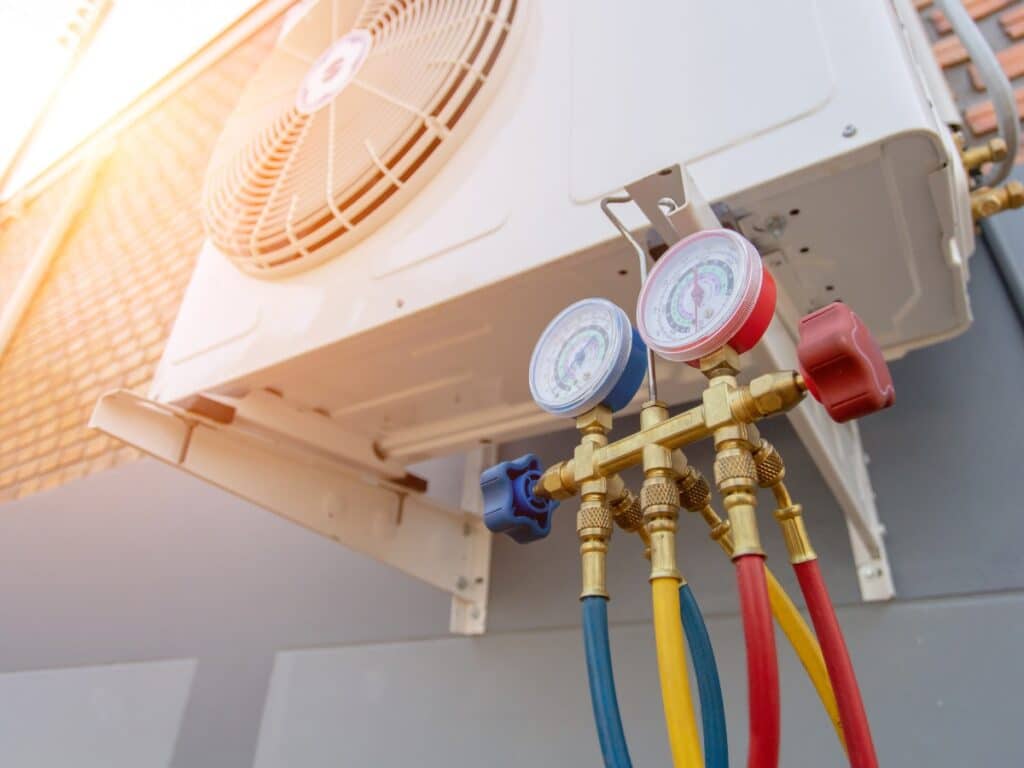Portable air conditioners have become increasingly popular as a convenient and affordable way to cool single rooms. Whether renting an apartment, living in a small space, or looking to cool a specific area, a portable air conditioner can provide the comfort you need.
In this blog, we will explore how a portable air conditioner creates a vacuum and how it works to cool your space effectively. We will also discuss the different types of portable air conditioners, installation tips for maximum efficiency, and maintenance and care for these units. By the end of this blog, you will have a comprehensive understanding of how portable air conditioners work and how to make the most of your cooling experience.
Understanding Portable Air Conditioners
Portable air conditioners are standalone units that can quickly move from one room to another. They are designed to cool a specific area without needing permanent installation. These units work by extracting warm air from the room, cooling it down, and recirculating the cooled air back into the space.
They rely on the principle of heat exchange and use refrigerants to absorb and release heat. Portable air conditioners also help improve air quality by filtering dust, allergens, and other pollutants.
The Basics of Portable AC Units
Portable AC units consist of a cooling unit and an exhaust hose. The cooling unit contains the evaporator coil, which cools the air, and the condenser coil, which releases the heat.
The exhaust hose expels the hot air generated during the cooling process. Proper venting of the exhaust hose to the outside of the room is essential to ensure efficient cooling. Some portable AC units come with window installation kits, allowing easy venting through a window. Others may require additional accessories or modifications for proper venting.
How Portable Air Conditioners Work
Portable air conditioners work by taking in warm air from the room and passing it over a refrigerant cooling coil. The refrigerant absorbs the heat as the warm air passes over the coil, causing the air to cool down.
The cooled air is then recirculated back into the room. At the same time, the heat absorbed by the refrigerant is released outside through the exhaust hose. This process creates a continuous cycle of warm air being cooled and expelled and cool air being circulated back into the room. The exhaust hose plays a crucial role in maintaining the efficiency of the cooling process by removing the hot air from the room.
What Creates the Vacuum in Portable ACs?
The vacuum in a portable air conditioner is created by the airflow within the unit and the design of the exhaust hose. As the warm air enters the unit, it creates a negative pressure that helps to draw in more warm air from the room. This continuous flow of warm air allows the cooling process to occur efficiently.
The exhaust hose plays a crucial role in maintaining the vacuum by expelling the hot air generated during the cooling process. It is essential to ensure that the exhaust hose is installed correctly and vented to the outside of the room to maintain the vacuum and maximize cooling efficiency. The sealed system of the portable AC prevents the mixing of outside air with the cooled air, ensuring that the desired temperature is maintained.
The Role of Airflow in Vacuum Creation
Airflow is essential in creating and maintaining the vacuum in a portable air conditioner. The unit’s design ensures a continuous flow of warm air entering the unit, which helps to create the vacuum necessary for the cooling process. The airflow is carefully controlled to ensure maximum efficiency and cooling performance.
The portable air conditioner’s intake vents draw warm air from the room, while the exhaust vents expel hot air generated during the cooling process. Proper airflow is essential for the portable air conditioner to function effectively and efficiently. Keeping the intake and exhaust vents clean and free from obstructions is essential to ensure optimal airflow and cooling performance.
Types of Portable Air Conditioners
There are two main types of portable air conditioners: single-hose and dual-hose. Single-hose units have one exhaust hose that expels the hot air generated during the cooling process. Dual-hose units have two exhaust hoses: one for expelling the hot air and the other for drawing in fresh air from outside.
Both types of portable air conditioners have advantages and disadvantages, and the choice between them depends on factors such as cooling capacity, ambient air temperature, and personal preference.
Single-Hose vs. Dual-Hose Systems
Single-hose systems:
- Use one exhaust hose to expel hot air and moisture
- It can be less efficient if the outdoor air is hot or humid
- We may need to remove the air intake hose on humid days
- Lower upfront cost
- Easier to set up and move from room to room
Dual-hose systems:
- Use two exhaust hoses: one for expelling hot air and the other for drawing in fresh air
- Can cool a room more quickly and efficiently
- Filters last longer as the unit brings in fresh air from outside
- Use less energy to cool a larger room
- Higher upfront cost
- More difficult to set up and move from room to room
- Lower upfront cost compared to dual-hose units.
- Choose a location near a window or door for easy venting.
Proper Placement and Venting Techniques
Proper placement and venting are crucial for efficiently operating a portable air conditioner. Follow these techniques to ensure optimal cooling:
- Place the portable AC near a window or door for easy venting.
- Use the provided window kit to seal the gap around the exhaust hose.
- Extend the exhaust hose to its full length for maximum effectiveness.
- Ensure that the exhaust hose is not kinked or bent, which can restrict airflow.
Avoiding Common Installation Mistakes
When installing a portable air conditioner, it’s essential to avoid common mistakes affecting its performance. Here are some mistakes to avoid:
- Improper insulation: Ensure the window or door opening is adequately insulated to prevent air leaks and maintain efficient cooling.
- Incorrect venting: Ensure the exhaust hose is connected correctly and sealed to prevent hot air from entering the room.
- Overlooking proper drainage: Portable air conditioners produce condensation that needs to be drained properly. Check the unit’s manual for instructions on how to drain the condensation.
Troubleshooting Common Issues
Sometimes, portable air conditioners may encounter common issues affecting their performance. Here are some troubleshooting tips for common problems:
- Inspect the exhaust hose for any leaks or tears. If found, replace the hose.
- Check the exhaust vent for any blockages or obstructions and clear them if necessary.
- Make sure that the unit is correctly plugged into a functioning power outlet.
- Check the settings and temperature settings to ensure they are correctly adjusted.
- If the unit is not cooling correctly, ensure the room is adequately sealed and insulated.
- If the unit makes unusual noises, check for any loose parts or obstructions.
Ensuring Proper Ventilation
Proper ventilation is essential when using a portable air conditioner to ensure the efficient operation of the unit and maintain a healthy indoor environment. Here are some tips for ensuring proper ventilation:
- Use the provided window installation kit to seal the gap around the exhaust hose, ensuring hot air is vented outside.
- Avoid blocking the intake and exhaust vents of the portable AC, as this can restrict airflow and reduce its cooling effectiveness.
- Keep doors and windows closed while the portable AC is running to create a more efficient cooling zone and prevent the influx of warm air.
- Consider using additional fans or air purifiers to circulate and filter fresh air, especially in rooms without proper ventilation.

Comparing Portable Air Conditioners
Several factors should be considered when comparing portable air conditioners, including cooling capacity and energy efficiency. Here’s an overview of what to look for:
- Cooling Capacity: Consider the portable AC’s British thermal unit (BTU) rating. The higher the BTU, the greater the cooling capacity. Choose a unit with a BTU rating suitable for the room size you want to cool.
- Energy Efficiency: Look for a unit with a high energy efficiency ratio (EER). The EER compares the cooling capacity (in BTU/hour) with the energy use (in watts). A higher EER indicates greater energy efficiency and lower energy costs.
You can choose the one that best meets your cooling needs by comparing the cooling capacity and energy efficiency of different portable air conditioners.
Key Features to Look For
When choosing a portable air conditioner, it’s essential to consider the key features that can enhance its functionality and convenience. Here are some features to look for:
- Remote Control: A remote control allows you to adjust the settings and temperature from a distance, providing convenience and ease of use.
- Caster Wheels: Portable ACs with caster wheels can be easily moved from one room to another, allowing for greater flexibility and portability.
- Adjustable Thermostat: An adjustable thermostat allows you to set and maintain the desired temperature, keeping your room comfortable and relaxed.
- Timer Function: A timer function allows you to schedule when the portable AC turns on and off, helping to save energy and control cooling costs.
Understanding how a portable air conditioner creates a vacuum is crucial for optimal efficiency. By grasping the science behind its operation, you can ensure proper installation, maintenance, and care for your unit. Whether you opt for a single-hose or dual-hose system, knowing the impact on the room environment and air quality is key.
Remember to prioritize ventilation and choose a model with essential features. With routine cleaning and troubleshooting, your portable AC can provide reliable cooling without drastically affecting your energy bill. Stay informed, and make the most of your portable air conditioner for a comfortable living space.

